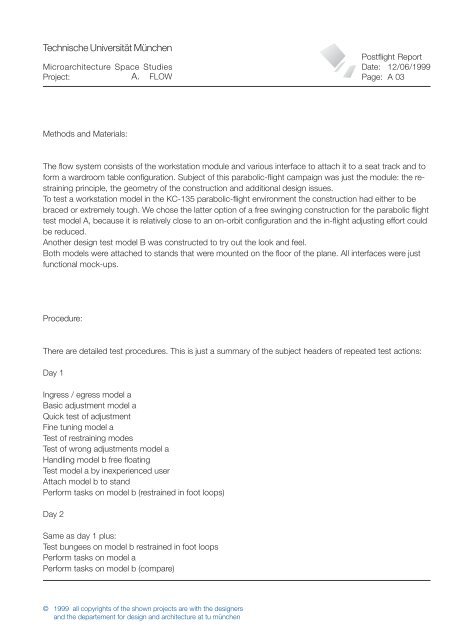Microarchitecture Space Studies Report - Technische Universität ...
Microarchitecture Space Studies Report - Technische Universität ... Microarchitecture Space Studies Report - Technische Universität ...
Technische Universität München Microarchitecture Space Studies Project: A. FLOW Methods and Materials: © 1999 all copyrights of the shown projects are with the designers and the departement for design and architecture at tu münchen Postflight Report Date: 12/06/1999 Page: A 03 The flow system consists of the workstation module and various interface to attach it to a seat track and to form a wardroom table configuration. Subject of this parabolic-flight campaign was just the module: the restraining principle, the geometry of the construction and additional design issues. To test a workstation model in the KC-135 parabolic-flight environment the construction had either to be braced or extremely tough. We chose the latter option of a free swinging construction for the parabolic flight test model A, because it is relatively close to an on-orbit configuration and the in-flight adjusting effort could be reduced. Another design test model B was constructed to try out the look and feel. Both models were attached to stands that were mounted on the floor of the plane. All interfaces were just functional mock-ups. Procedure: There are detailed test procedures. This is just a summary of the subject headers of repeated test actions: Day 1 Ingress / egress model a Basic adjustment model a Quick test of adjustment Fine tuning model a Test of restraining modes Test of wrong adjustments model a Handling model b free floating Test model a by inexperienced user Attach model b to stand Perform tasks on model b (restrained in foot loops) Day 2 Same as day 1 plus: Test bungees on model b restrained in foot loops Perform tasks on model a Perform tasks on model b (compare)
Technische Universität München Microarchitecture Space Studies Project: A. FLOW Results, Discussion: © 1999 all copyrights of the shown projects are with the designers and the departement for design and architecture at tu münchen Postflight Report Date: 12/06/1999 Page: A 04 The flights prove our results from the underwater tests; the restraining principle does work. We got some insights into the problems users might have with the restraining mechanisms and discussed possible solutions. Despite the model unique adjustment difficulties (caused by the extreme mass and construction solutions that we had to choose to match the KC-135 safety criteria) the adjustment system and procedure prove to be viable. The flight hardware concept model B showed that the handling of the system in micro-g is no problem. We just found that the interface concept needs more work. Of course the whole engineering is still in the concept phase. Conclusion: We think that the system of the flow table is a solution for several important problems of living in a micro-g environment. The flight campaign prove the quality of the concept and we could verify our basic assumptions. Advancing from this, it is possible to develop actual flight hardware.
- Page 1 and 2: © 1999 all copyrights of the shown
- Page 3 and 4: Technische Universität München Mi
- Page 5: Technische Universität München Mi
- Page 9 and 10: Technische Universität München Mi
- Page 11 and 12: Technische Universität München Mi
- Page 13 and 14: Technische Universität München Mi
- Page 15 and 16: Technische Universität München Mi
- Page 17 and 18: Technische Universität München Mi
- Page 19 and 20: Technische Universität München Su
- Page 21 and 22: Technische Universität München Su
- Page 23 and 24: Technische Universität München Mi
- Page 25 and 26: Technische Universität München Mi
- Page 27 and 28: Technische Universität München Mi
- Page 29 and 30: Technische Universität München Mi
- Page 31 and 32: Technische Universität München Mi
- Page 33 and 34: Technische Universität München Mi
<strong>Technische</strong> <strong>Universität</strong> München<br />
<strong>Microarchitecture</strong> <strong>Space</strong> <strong>Studies</strong><br />
Project: A. FLOW<br />
Methods and Materials:<br />
© 1999 all copyrights of the shown projects are with the designers<br />
and the departement for design and architecture at tu münchen<br />
Postflight <strong>Report</strong><br />
Date: 12/06/1999<br />
Page: A 03<br />
The flow system consists of the workstation module and various interface to attach it to a seat track and to<br />
form a wardroom table configuration. Subject of this parabolic-flight campaign was just the module: the restraining<br />
principle, the geometry of the construction and additional design issues.<br />
To test a workstation model in the KC-135 parabolic-flight environment the construction had either to be<br />
braced or extremely tough. We chose the latter option of a free swinging construction for the parabolic flight<br />
test model A, because it is relatively close to an on-orbit configuration and the in-flight adjusting effort could<br />
be reduced.<br />
Another design test model B was constructed to try out the look and feel.<br />
Both models were attached to stands that were mounted on the floor of the plane. All interfaces were just<br />
functional mock-ups.<br />
Procedure:<br />
There are detailed test procedures. This is just a summary of the subject headers of repeated test actions:<br />
Day 1<br />
Ingress / egress model a<br />
Basic adjustment model a<br />
Quick test of adjustment<br />
Fine tuning model a<br />
Test of restraining modes<br />
Test of wrong adjustments model a<br />
Handling model b free floating<br />
Test model a by inexperienced user<br />
Attach model b to stand<br />
Perform tasks on model b (restrained in foot loops)<br />
Day 2<br />
Same as day 1 plus:<br />
Test bungees on model b restrained in foot loops<br />
Perform tasks on model a<br />
Perform tasks on model b (compare)



